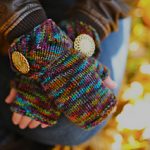
(photo © Theressa Silver)
Theressa Silver is a freelance designer and was our guest at the August meeting. The topic of her presentation was Perfect Pairing: Choosing the Right Yarn for Your Project and she gave us lots of useful information. You may have picked a lovely pattern, a gorgeous yarn, and been spot on with gauge but in the end you just don’t like the finished item. The problem most likely isn’t the pattern OR the yarn, but rather the combination of the two.
Theressa discussed fabic density – more stitches per inch gives higher density – and the importance of matching the density to the garment’s use. Mittens and socks need dense fabric to be comfortable and wear well whereas scarves and shawls will be lovely in a less dense fabric which will drape around the body.
The same gauge can be achieved with both a fingering weight and worsted weight yarn but the density will be completely different. When substituting yarns for a pattern look closely at the yarn weight, needle size, and gauge the designer has used. This will give you a guide to the fabric density of the pattern.
The design elements of the pattern will be affected by the fabric density. A slouchy hat or lace shawl will use a fabric that drapes while cables in that fabric would look indistinct. Yarn color can either emphasize or hide a stitch pattern so be sure to swatch a large enough sample to get a good look at the interaction of the color and stitch pattern. It can be fun to include cables and lace along with stockinette and garter stitches in a swatch.
Knitters have a plethora of choices in yarns. There are seemingly endless combinations of not only weights and colors but also fiber types, ply structures, and amount of twist. There are some excellent books in the library for anyone who wants to learn more. Theressa discussed some of the basic characteristics of the most common fiber types. Although these traits are generally true, any specific yarn must be evaluated on its own because spinning, plying, and blending of types can change the character of any yarn.
Wool – a favorite because it comes in so many varieties – there is a wool yarn for almost every purpose
Alpaca – very warm, drapey, fuzzy, lustrous; won’t hold ribbing well, may obscure lace, many natural colors
Cashmere – soft, drapey, delicate; usually found blended with other types
Cotton – little elasticity; may sag, can be tiring to work with look for a pattern designed for cotton yarn, yarns vary tremedously depending on preparation
Silk – strong, shiney, drapey; adds beautiful shine, drape, and durability to the yarn
Linen – durable, inelastic, stiff and rough until washed, absorbent; beauiful drape, favorite for summer tops
Yarnsub.com is a fun website to explore for yarn substitutions. With all this information we will be able to make better choices matching yarns and patterns to create things we love.
